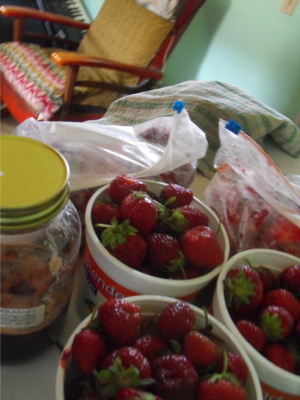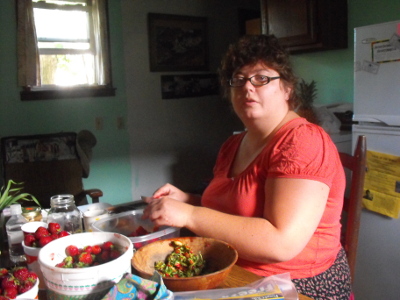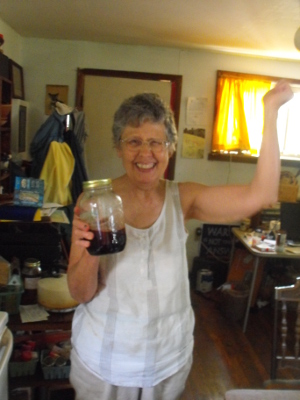
How to grow the tastiest strawberries
 Compared
to storebought strawberries, or even to fruits from conventional
you-pick operations, any kind of homegrown strawberry is
delicious. However, once I'd been spoiled by gorging on my own
berries for two weeks, I started to notice taste differences from bed
to bed. My favorite beds became the source of strawberries for
fresh eating, while other beds were relegated freezer jam or strawberry
leather.
What's the
difference?
Compared
to storebought strawberries, or even to fruits from conventional
you-pick operations, any kind of homegrown strawberry is
delicious. However, once I'd been spoiled by gorging on my own
berries for two weeks, I started to notice taste differences from bed
to bed. My favorite beds became the source of strawberries for
fresh eating, while other beds were relegated freezer jam or strawberry
leather.
What's the
difference?
I've written previously
about how heavy
rains can cause micronutrient deficiencies that in turn degrade the
taste of strawberries.
Similarly, I mentioned that strawberries
picked on hot, sunny afternoons are tastier than those picked in the
morning or soon after rains.
These factors aren't influencing the current taste differences, though,
since all of our plants have been exposed to the same rainy weather.
Variety is one obvious
cause of taste differences. In addition to our alpine
strawberries,
we're growing two June-bearing varieties (Honeoye and Jewel) and one
ever-bearing variety (Ozark Beauty.) The fruits are smaller and
less prolific on the Ozark Beauty, but these plants are our consistent
taste-test winners. Honeoye is a close runner up, especially
early in the season, although the flavor tends to degrade as the
plants reach the end of their fruiting season. Jewel is my least
favorite strawberry for flavor, but I've kept growing it  because the
fruits start a couple of weeks later than Honeoye (our earliest
variety), extending spring strawberry season to a full month. If
anyone has a favorite late, June-bearing strawberry, I'd love to hear
what
variety you grow!
because the
fruits start a couple of weeks later than Honeoye (our earliest
variety), extending spring strawberry season to a full month. If
anyone has a favorite late, June-bearing strawberry, I'd love to hear
what
variety you grow!
Another factor that
causes a decline in fruit quality is age of the
strawberry bed. Each season after the plants stop producing, I
drastically thin the beds and add a heavy top-dressing of composted
manure. Despite all of this TLC, our best-tasting strawberries
still come from the beds that I just planted
last fall.
These beds don't produce nearly as much fruit since the plants have had
less than a year to store up energy, but what they lack in quantity
they make up in quality. I suspect that the best rotation would
be allowing strawberry plants to stay in the ground for two years so
that I can have heavy yields for drying from the older beds while
saving the fruits from the younger beds for our table.
 When I did a blind taste test
of our strawberry beds and compared my
flavor rating to the age of the bed, one four year old bed produced
strawberries just as delicious (or maybe more so!) than the newest
beds. This elderly bed is located in the part of the garden that
was used by the previous owners as an ash heap, and decades later, big
chunks of biochar are still visible in the soil. Could the
biochar be responsible for this aberration in flavor? I guess I
know which crops I'll use with my next biochar
experiment!
When I did a blind taste test
of our strawberry beds and compared my
flavor rating to the age of the bed, one four year old bed produced
strawberries just as delicious (or maybe more so!) than the newest
beds. This elderly bed is located in the part of the garden that
was used by the previous owners as an ash heap, and decades later, big
chunks of biochar are still visible in the soil. Could the
biochar be responsible for this aberration in flavor? I guess I
know which crops I'll use with my next biochar
experiment!
(As a side note, the
photos in this post showcase Mom and Maggie's experiments with their
three gallons of Walden Effect strawberries. Half a gallon were
given away, a gallon were topped and put in the freezer, three cups
turned into a honey-sweetened jam, and the rest were eaten raw or saved
for more experiments.)
Want more in-depth information? Browse through our books.
Or explore more posts by date or by subject.
About us: Anna Hess and Mark Hamilton spent over a decade living self-sufficiently in the mountains of Virginia before moving north to start over from scratch in the foothills of Ohio. They've experimented with permaculture, no-till gardening, trailersteading, home-based microbusinesses and much more, writing about their adventures in both blogs and books.
Want to be notified when new comments are posted on this page? Click on the RSS button after you add a comment to subscribe to the comment feed, or simply check the box beside "email replies to me" while writing your comment.
- Remove comment
- Remove comment
